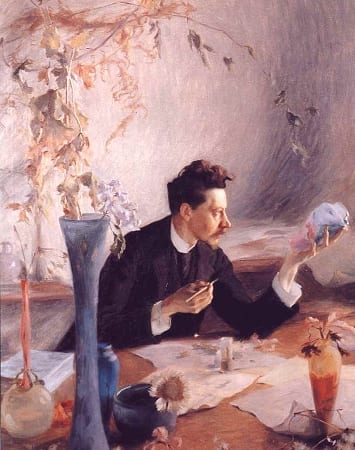
Who Was Alphonse Mucha?
Early Life
Alphonse Maria Mucha was a Chech painter and graphic artist from the town of Ivancice, Moravia (the present area of Czech Republic). His singing capacities enabled him to proceed with his training through secondary school in the Moravian capital of Brünn (today Brno), despite the fact that drawing had been his first love since his youth. He worked at enriching painting tasks in Moravia, until1879 when he moved to Vienna to work for a main Viennese dramatic plan organization, while casually facilitating his aesthetic instruction. At the point when a terminate crushed his boss’ business in 1881, he came back to Moravia, doing independent improving and representation painting. Check Karl Khuen of Mikulov procured Mucha to design Hrusovany Emmahof Castle with wall paintings and was sufficiently awed that he consented to support Mucha’s formal preparing at the Munich Academy of Fine Arts.
In 1887, Mucha changed his course again and moved to Paris in order to continue his artistic education at the Académie Julian and Académie Colarossi while additionally delivering magazine outlines. In the winter of 1894, he made a poster for a Victorien Sardou’s play Gisamonda featuring that time’s greatest female artist, Sarah Bernhardt. The actress was so happy with the accomplishment of the Mucha’s first theater poster that she made a 6-year contract with him.
Mucha delivered a whirlwind of artistic creations, notices, promotions, and book covers. He also created floor coverings, jewelry designs, and theater sets that were at first called the Mucha Style, however, ended up known as Art Nouveau.
Mucha also designed Neoclassical looking robes, frequently encompassed by rich blooms which in some cases framed haloes behind the ladies’ heads.
He also worked and decorated on the pavilions Bosnia and Herzegovina and Austria.
His Art Nouveau style was frequently imitated, although he was trying to leave a distinct footprint in the world of art.
However, his compositions came simply from his inner world influenced by Czech art and for him, art existed just to impart a profound message and nothing more, and that’s how he wanted his style to be recognized.
Marriage
Mucha got married in June 1906, to Maruska Chytilová in Prague. The couple lived in the U.S. for four years (1906-1910) where they got their first child, Jaroslava. Later on, they had a boy, Jiri, born on March 12, 1915, in Prague, who later turned into a notable columnist, essayist, screenwriter, and a novelist.
After the family came back to the Czech grounds and settled in Prague, Mucha did some important works like decorating the Theater of Fine Arts, contributing the wall paintings in the Mayor’s Office at the Municipal House, and enriching with art many tourist spots around the Czech’s capital.
Le Parter
According to Mucha, his greatest printed masterpiece and the best example of his unique art is Le Parter. He actually gave the best description of his own work of art, saying that he put his soul into it.
The Slav Epic
Without any doubt, one of Mucha’s most spectacular pieces of art is the Slav Epic, a series of twenty enormous paintings portraying the turbulent history of the Czech and Slavic people in general.
Death
Being famous for his Slavic fanatism, Mucha was one of the first people who got arrested by the Gestapo when the German troops invaded Czhekoslovakia in 1939. As he was already ill of pneumonia, his medical conditions got worse during the interrogation process, and he passed away shortly after being released that same year in July.
Legacy
Mucha’s style got totally underrated during the time of his death and the only one who at that time made sure to give credits to Mucha’s unique art was his writer son, Jiri Mucha.
Nevertheless, Mucha’s masterpieces reborn in the 1960s when his Art Nouveau became an inspiration for artists like Waymouth and English, who designed album covers for Pink Floyd.
His Slav Epic was stored for more than 25 years, but fortunately, Mucha finally got his museum in Prague, founded by his grandson John Mucha.
A lot of illustrators and artists ‘borrow’ Mucha’s artistic style in the modern time and they create new works of art that definitely remind us of the exquisite talent of the Czech painter Alfonse Mucha. Some of the artists that copy Mucha’s style are Paul Harvey, Naoko Takeuchi, Masakazu Katsura, and many Marvel comic book illustrators.



